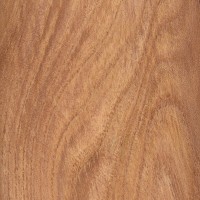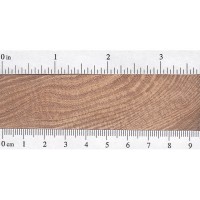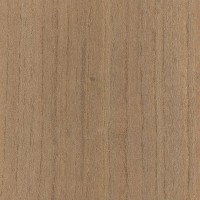 |
Common Name(s): English Elm, Carpathian Elm Scientific Name: Ulmus procera Distribution: Western Europe Tree Size: 80-115 ft (25-35 m) tall, 3-6 ft (1-2 m) trunk diameter Average Dried Weight: 35 lbs/ft3 (565 kg/m3) Specific Gravity (Basic, 12% MC): .49, .57 Janka Hardness: 810 lbf (3,620 N) Modulus of Rupture: 9,430 lbf/in2 (65.0 MPa) Elastic Modulus: 1,032,000 lbf/in2 (7.12 GPa) Crushing Strength: 4,740 lbf/in2 (32.7 MPa) Shrinkage: Radial: 5.0%, Tangential: 7.0%, |
Color/Appearance: Heartwood is light to medium reddish brown. Paler sapwood is usually well defined. Burls of English Elm are frequently referred to as Carpathian Elm burl.
Grain/Texture: Grain is interlocked (making it very resistant to splitting). With a somewhat coarse, uneven texture.
Rot Resistance: Rated as non-durable; susceptible to insect attack. Living trees are susceptible to Dutch elm disease.
Workability: Can be a challenge to work because of interlocked grain, especially on quartersawn surfaces. Planing can cause tearout and/or fuzzy surfaces. Poor dimensional stability. Glues, stains, and finishes well. Responds well to steam bending, and holds nails and screws well.
Odor: Elm usually has a strong, unpleasant smell when green; though once dried has very little odor.
Allergies/Toxicity: Although severe reactions are quite uncommon, Elm in the Ulmus genus has been reported as a sensitizer. Usually most common reactions simply include eye and skin irritation. See the articles Wood Allergies and Toxicity and Wood Dust Safety for more information.
Pricing/Availability: Should be moderately priced within its natural habitat in Europe, though availability from mature trees has been greatly diminished by Dutch elm disease. Carpathian Elm burl veneer is occasionally available, and is among the most expensive veneers commercially available.
Sustainability: This wood species is not listed in the CITES Appendices or on the IUCN Red List of Threatened Species.
Common Uses: Boxes, baskets, furniture, hockey sticks, veneer, archery bows, and paper (pulpwood).
Comments: Elm trees are commonly infected with Dutch elm disease, a fungal disease spread by elm bark beetles. D.E.D. has wiped out millions of Elm trees worldwide.
Scans/Pictures: A special thanks to Steve Earis for providing the wood sample and turned photo of this wood species.










Looking up the wood making up the stock of my Zastava M48, which is supposedly beech or elm. After looking up the two I’d say it’s elm, though I’m wood-stupid so who knows. It’s in surprisingly decent shape for being 70 years old but I’m gonna refinish it and put some protectant on it so it keeps.
Regarding the oder, I do not agree. Even dry, it has a very distinct odor when worked.
I have made a desk out of elm. And it’s dried obviously. Wide boards, no shrinkage anymore so it’s seasoned. After more than half a year it still gives off old socks smell, very faint though, but noticeable. My gf was asking me if I have some old socks laying around when she was sitting around the desk. Definite drawback of this wood.
Is Elm good for making rustic furniture, such as large slabs for tabletops, benches, etc? Also, is Sycamore Maple, and Hemlock also good for making rustic furniture? Thanks, Olaf Snyder
Could you please Help me? I have two HUGE over 100 years old ELM trees, I had it cut because of elm disease. I have a lot of this wood, and i would like to pick some pieces for a small round table, etc I am not sure how to select them. My neighbors are taken the rest of the wood. Before they take it I want some of my wood to keep. I will appreciate any help I can have in how to select my ELM wood for furniture and also to have a little of my loved trees… Read more »
If the tree is very large, I would get some quartersawn pieces, which will be more stable. Elm lumber can be beautiful, but it’s not the most stable wood around in regards to humidity changes.
Thank you for the reply.
The trees were very beautiful, tall and large. Now they are already cut into pieces! I want to keep some pieces of it to make a table from a slice of the trunk and seats from smaller branches. I already saw a round sliced of it which has very beautiful natural designs in it. I just want to pick the best for its’ natural beauty.
You are very kind. Thank you very much for your help.
Since Carpathian Elm is just the burl form of English Elm, I initially had the two species listed on the same page. I’ve now since separated them into two distinct pages, similar to the superficial division between Narra and Amboyna.
Dear WD,
An HMTL bug: The link to Carpathian Elm misdirects to this page.
Best regards from Melbourne, Australia,
Rachel
thank you